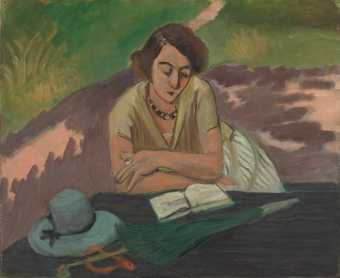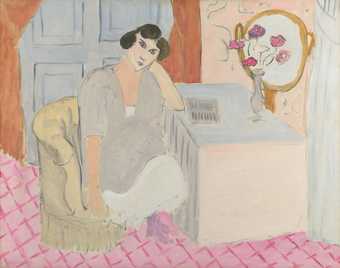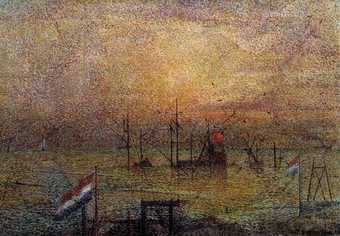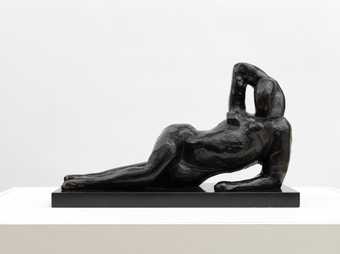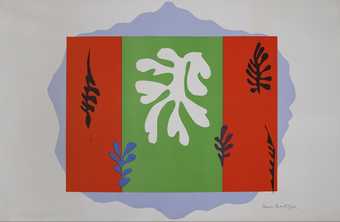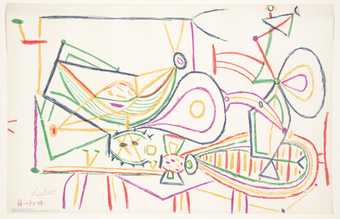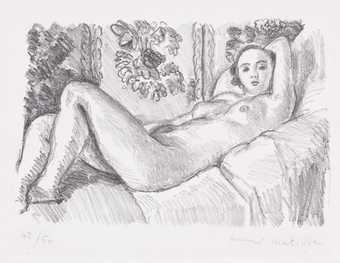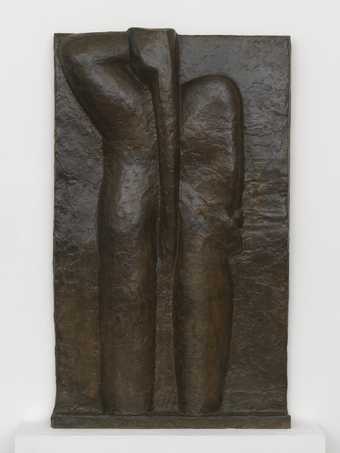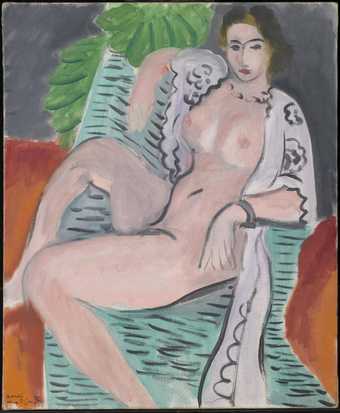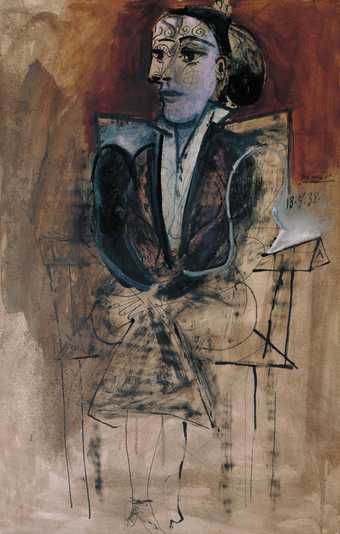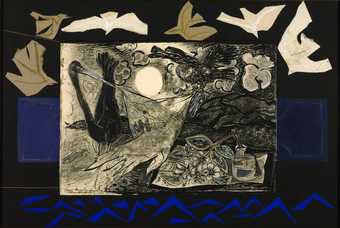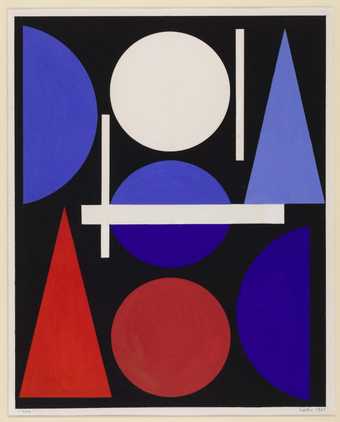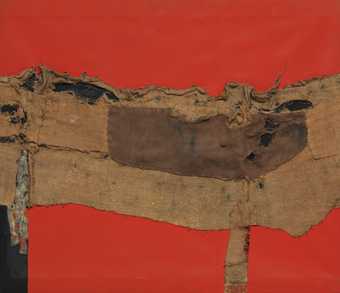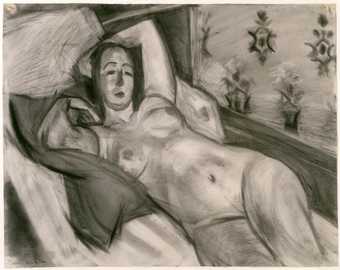
In Tate Modern
- Artist
- Henri Matisse 1869–1954
- Original title
- L'Escargot
- Medium
- Gouache on paper, cut and pasted on paper mounted on canvas
- Dimensions
- Support: 2864 × 2870 mm
frame: 2954 × 2962 × 100 mm - Collection
- Tate
- Acquisition
- Purchased with assistance from the Friends of the Tate Gallery 1962
- Reference
- T00540
Summary
After 1948 Matisse was prevented from painting by ill health but, although confined to bed, he produced a number of works known as gouaches découpées. These were made by cutting or tearing shapes from paper which had been painted with gouache. The shapes were placed and pasted down by an assistant working under Matisse's instruction. Some of the later ones, such as The Snail, were of very large dimensions. The technique, explored in his picture book Jazz (published 1947) and other works, opened up new possibilities for him. Matisse said of the technique that it 'allows me to draw in the colour. It is a simplification for me. Instead of drawing the outline and putting the colour inside it - the one modifying the other - I draw straight into the colour' (quoted in Amis de l'art, October 1951).
His secretary Mme Lydia Delectorskaya described the making of The Snail (letter to the Tate Gallery, 30 March 1976):
The Snail was made in the Hôtel Régina at Nice. H. Matisse had at his disposal sheets of paper painted in gouache by assistants, in all the colours he used for the 'papiers découpés'. A background of white paper - of the dimensions indicated by H.M. - was put on the wall and the assistant pinned onto it the pieces of gouached paper which H.M. passed to him indicating exactly where they should be placed. When H.M. decided that his composition was finished, it was lightly stuck to the background. The panel was taken down when H.M. needed the wall for a further work. When later on it was sent to Lefebvre-Foinet [in Paris] to be pasted down, before anything was moved, an extremely precise tracing was made to ensure that no changes were made in the composition, not even by so much as a millimetre.
Matisse's daughter Mme Duthuit said that her father made many drawings of snails at this time and that the idea for this work came out of these. The concentric pattern formed by the coloured shapes in the centre of the work echoes the spiral pattern found in the snail's shell. Matisse told André Verdet (pp.64-5), 'I first of all drew the snail from nature, holding it. I became aware of an unrolling, I found an image in my mind purified of the shell, then I took the scissors'. He has combined pairs of complementary colours - red/green, orange/blue, yellow/mauve - to create a particularly vibrant effect. He gave the picture the alternative title La Composition Chromatique [Chromatic Composition].
Further reading:
André Verdet, Prestiges de Matisse, Paris 1952, pp.64-5
John Jacobus, Henri Matisse, London 1973, p.180, reproduced p.154 in colour
Ronald Alley, Catalogue of the Tate Gallery's Collection of Modern Art other than Works by British Artists, London 1981, pp.500-02, reproduced p.500
Terry Riggs
February 1998
Does this text contain inaccurate information or language that you feel we should improve or change? We would like to hear from you.
Display caption
WHAT EFFECTS ARE CREATED BY PLACING DIFFERENT COLOURS NEXT TO EACH OTHER?
Henri Matisse loved making art. But when he was in his 60s ill health made it difficult for him to paint. Instead he started ‘painting with scissors’, cutting painted paper into shapes. He had assistants to help him in the studio. They moved the paper pieces following Matisse’s directions, pinning them to the walls of his studio. If you look closely at The Snail you can see small pin holes. Matisse has arranged the paper in the spiral shape of a snail’s shell, placing colours next to each other to create a vibrant effect: green and red, orange and blue, pink and yellow.
‘It is not enough to place colours, however beautiful, one beside the other; colours must also react on one another.’
Gallery label, July 2020
Does this text contain inaccurate information or language that you feel we should improve or change? We would like to hear from you.
Catalogue entry
Henri Matisse 1869-1954
T00540 L'Escargot (The Snail) 1953
Inscribed 'H.Matisse | 53' b.r.
Gouache on cut-and-pasted paper, 111 3/4 x 113 (287 x 288)
Purchased from Jean Matisse (Grant-in-Aid) with the aid of the Friends of the Tate Gallery 1962
Exh:
Henri Matisse 1950-1954: Les Grandes Gouaches Découpées, Kunsthalle, Bern, July-September 1959 (26, repr.); Henri Matisse: Les Grandes Gouaches Découpées, Stedelijk Museum, Amsterdam, April-June 1960 (20); Henri Matisse: Les Grandes Gouaches Découpées, Musée des Arts Décoratifs, Paris, March-May 1961 (35); The Last Works of Henri Matisse: Large Cut Gouaches, Museum of Modern Art, New York, October-December 1961 (29, repr.); Art Institute of Chicago, January-February 1962 (29, repr.); San Francisco Museum of Art, March-April 1962 (29, repr.); Matisse 1869-1954, Hayward Gallery, London, July-September 1968 (136, repr. in colour)
Lit:
André Verdet, Prestiges de Matisse
(Paris 1952), pp.64-5; Jacques Lassaigne, Matisse
(Geneva 1959), p.124; John Jacobus, Henri Matisse
(London 1973), p.180, repr. p.181 in colour
Repr:
Pierre Reverdy and Georges Duthuit, Dernières Oeuvres de Matisse 1950-1954
(Verve, Nos.35-6, Paris 1958), p.154 in colour
Matisse's gouaches découpées, together with the decoration of the Chapel of the Rosary at Vence, are the crowning achievement of his last years. Unable after 1948 to work at his easel, confined to bed because of ill health, he made a number of gouaches découpées, some of the later ones like this of very large dimensions. He cut out the shapes with a pair of scissors and they were pinned in place by assistants under his direction.
This technique, which he had begun to explore earlier in his picture book Jazz
and other works, opened up new possibilities for him. 'Papier découpé', he said, 'allows me to draw in the colour. It is a simplification for me. Instead of drawing the outline and putting the colour inside it - the one modifying the other - I draw straight into the colour ...' (Quoted in Amis de l'Art, N.S.2, October 1951).
His secretary Mme Lydia Delectorskaya has described the making of 'The Snail' as follows (letter of 30 March 1976):
'"The Snail" was made in the Hôtel Régina at Nice.
'H. Matisse always had at his disposal sheets of paper painted in gouache by assistants, in all the colours he used for the "papiers découpés".
'A background of white paper - of the dimensions indicated by H.M. - was put on the wall and the assistant pinned onto it the pieces of gouached paper which H.M. passed to him indicating exactly where they should be placed. When H.M. decided that his composition was finished, it was lightly stuck to the background. The panel was taken down when H.M. needed the wall for a further work.
'When later on it was sent to Lefebvre-Foinet [in Paris] to be pasted down, before anything was moved, an extremely precise tracing was made to ensure that no changes were made in the composition, not even by so much as a millimetre.
'There were no preparatory drawings for this work by H. Matisse.
'Its title "The Snail" comes from the form made up of a succession of patches of colour: they curl round like the shell of a snail. The spiral form of a snail's shell echoes the direction of universal movement. The composition so named is therefore not at all abstract. But if you want to treat it as "abstract", you can give it the alternative title also chosen by H. Matisse: "La Composition Chromatique" [Chromatic Composition].'
Maurice Lefebvre-Foinet added (letter of 19 February 1976): 'Entrusted personally with the completion of the collages by M. Henri Matisse, we had the work pinned onto paper - two very exact tracings were made.
'We used raw canvas which had been sponged over twice and attached to a temporary stretcher.
'Thin paper was pasted onto this canvas to serve as a support and a means of attachment. Next the paper of the background was pasted down, then the work itself was fixed ...
'This work was done by me with the help of M. Matisse's secretary, and completed and approved by the artist and Madame Duthuit.'
Mme Duthuit told the compiler that her father made many drawings of snails at this time and the idea for the papier découpé grew out of these. Shortly afterwards he designed a stained-glass window for the proposed mausoleum of Albert D. Lasker ('Ivy in Flower') and also designed an ironwork grill doorway to the mausoleum based on drawings of snails, which however was never executed.
André Verdet, op.cit., reproduces a small gouache découpée made in 1952 which is rather arabesque-like in form and which was also based on the stylisation of a snail. Matisse told him: 'I first of all drew the snail from nature, holding it between two fingers; drew it and redrew it. I became aware of an unrolling, I formed an image in my mind purified of the shell. Then I took the scissors.'
The theme later reached its monumental climax in 'The Snail', which is one of the most nearly abstract of all Matisse's works.
Published in:
Ronald Alley, Catalogue of the Tate Gallery's Collection of Modern Art other than Works by British Artists, Tate Gallery and Sotheby Parke-Bernet, London 1981, pp.500-2, reproduced p.500
Explore
- abstraction(8,615)
-
- from recognisable sources(3,634)
-
- figure(2,270)
- non-representational(6,161)
You might like
-
Henri Matisse Trivaux Pond
1916 or 1917 -
Henri Matisse Reading Woman with Parasol
1921 -
Henri Matisse The Inattentive Reader
1919 -
Elliott Seabrooke Evening at Zandvoort
1949 -
Henri Matisse Reclining Nude II
1927 -
Henri Matisse The Dancer
1949 -
Pablo Picasso Composition
1948 -
Henri Matisse Little Aurore
1923 -
Henri Matisse Back IV
1930, cast 1955–6 -
Henri Matisse Draped Nude
1936 -
Pablo Picasso Dora Maar Seated
1938 -
Ceri Richards Design for a Dropcloth: Homage to Dylan Thomas
1953–4 -
Auguste Herbin Nude
1960 -
Alberto Burri Sacking and Red
1954 -
Henri Matisse Reclining Nude
1924


